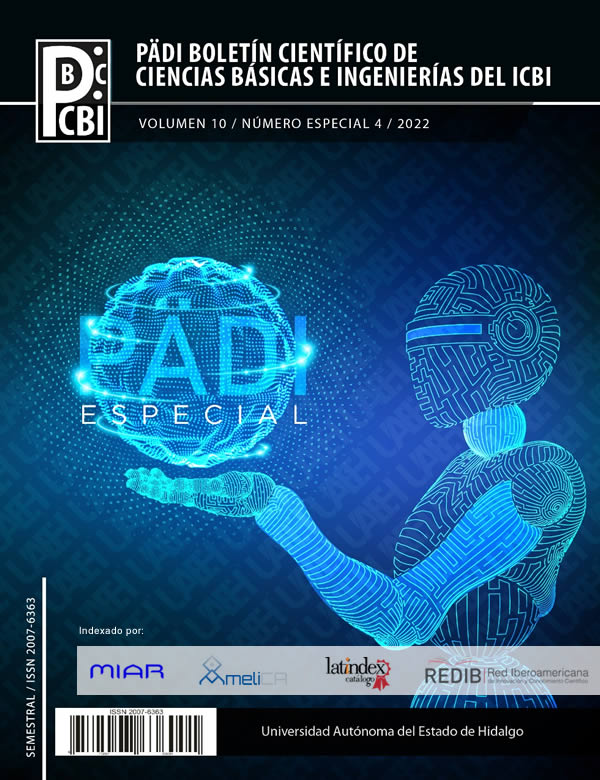Brain-computer interface for morse code interpretation through brain signals
BCI system for Morse code
Abstract
The necessity to offer a much effective communication way to handicap people leads us to do the do work where a Morse code blink-decoder is presented. To achieve the desired goal, brain signals were obtained using the brainwear EMOTIV Insight. The used channels are AF3 and AF4 since those are the channels where the wave perturbation is maximum due to blinks. Afterwards, the channels are filtered with a finite impulse response (FIR) filter, which is designed using different window functions such as classic functions as well as based on the Atomic Functions (AF) theory, with the objective to make a comparison of the results using different window functions. The results show a better classification of the blink type due to a better frequency response of the FIR filter using the AF as window.
Downloads
References
'5 Types Of Brain Waves Frequencies: Gamma, Beta, Alpha, Theta, Delta - Mental Health Daily. (2014). Retrieved April 30, 2022, from https://mentalhealthdaily.com/2014/04/15/5-types-of-brain-waves-frequencies-gamma-beta-alpha-theta-delta/
Andriantsilavo, H. S., Razafindrakoto, N. R., & Ratsimbazafy, A. (2021). Temporal Classification of EEG Signals for BCI Using Morse Code ( LIS Case ). 03(02), 18–21.
Atif Hassan, M., & Mehdi Rizvi, Q. (2008). Computer vs human brain: an analytical approach and overview. Certified Journal | Page, 9001.
Bansal, B. N., Singh, A., & Bhullar, J. S. (2018). A review of FIR filter designs. In Lecture Notes on Data Engineering and Communications Technologies (Vol. 3, pp. 125–140). Springer Science and Business Media Deutschland GmbH. https://doi.org/10.1007/978-981-10-4585-1_11
Brysina, I., Brysina, I. V., & Makarichev, V. O. (2018). Generalized atomic wavelets. Radioelectronic and computer systems, 0(1), 23–31. https://doi.org/10.32620/reks.2018.1.03
Budunova, K. A., & Kravchenko, V. F. (2021). New Digital Infinite Impulse Response Filters on Atomic Function ha(x). Progress in Electromagnetics Research Symposium, 2021-November, 270–279. https://doi.org/10.1109/PIERS53385.2021.9694722
EMOTIV Insight 2.0 - 5 Channel Mobile Brainwear® - EMOTIV. (n.d.). Retrieved May 12, 2022, from https://www.emotiv.com/product/emotiv-insight-5-channel-mobile-brainwear/
Harris, F. J. (1978). On the Use of Windows for Harmonic Analysis with the Discrete Fourier Transform. Proceedings of the IEEE, 66(1), 51–83. https://doi.org/10.1109/PROC.1978.10837
Hernandez-Matamoros, A., Fujita, H., Escamilla-Hernandez, E., Perez-Meana, H., & Nakano-Miyatake, M. (2020). Recognition of ECG signals using wavelet based on atomic functions. Biocybernetics and Biomedical Engineering, 40(2), 803–814. https://doi.org/10.1016/j.bbe.2020.02.007
Jiménez, R., & Mauledoux, M. (2018). Electroencephalogram ( EEG ) Sensor for Teleoperation of Domotics Applications via Virtual Environments. 13(14), 11577–11581.
Koudelková, Z., & Strmiska, M. (2018). Introduction to the identification of brain waves based on their frequency. MATEC Web of Conferences, 210. https://doi.org/10.1051/matecconf/201821005012
Kravchenko, V. F. al, Perez-Meana, H. M., & Ponomaryov, V. I. (2009). Adaptive digital processing of multidimentional signals with applications. Fizmatlit.
Kravchenko, V. F., & Churikov, D. V. (2011). Analytical Kravchenko-Kotelnikov and Kravchenko-Levitan wavelets in the digital UWB signal processing. Telecommunications and Radio Engineering (English Translation of Elektrosvyaz and Radiotekhnika), 70(9), 759–786. https://doi.org/10.1615/TELECOMRADENG.V70.I9.20
Kravchenko, V. F., Kravchenko, O. V., Konovalov, Y. Y., & Budunova, K. A. (2020). Atomic Functions Theory: History and Modern Results : Pioneer of Atomic Functions Theory V.L. Rvachev Invited Paper. 2020 IEEE Ukrainian Microwave Week, UkrMW 2020 - Proceedings, 619–623. https://doi.org/10.1109/UKRMW49653.2020.9252684
Michelli, A. G., González, N., Pose, F., Geria, J. M., & Martinez, N. (2019). Utilización de una Interfaz Cerebro- Computadora en Domótica. July.
Morse Code Timing | Morse Code World. (n.d.). Retrieved April 30, 2022, from https://morsecode.world/international/timing.html
Nuttall, A. H. (1981). Some Windows with Very Good Sidelobe Behavior. IEEE Transactions on Acoustics, Speech, and Signal Processing, 29(1), 84–91. https://doi.org/10.1109/TASSP.1981.1163506
Parker, R. O. (1988). Introduction To Digital Signal Processing. J Eng Comput Appl, 2(3), 6–10. https://doi.org/10.1201/9781439817391-5
Perez-Daniel, K., Escamilla-Hernandez, E., Nakano-Miyatake, M., & Perez-Meana, H. (2013). An Atomic function-based approach of Harris Affine detector. SoMeT 2013 - 12th IEEE International Conference on Intelligent Software Methodologies, Tools and Techniques, Proceedings, 2, 185–189. https://doi.org/10.1109/SoMeT.2013.6645678
Podder, P., Zaman Khan, T., Haque Khan, M., & Muktadir Rahman, M. (2014). Comparative Performance Analysis of Hamming, Hanning and Blackman Window. In International Journal of Computer Applications (Vol. 96, Issue 18).
Ponomarev, V. I.., Kravchenko, V. F., & Gomeztagle, F. (2009). Super-resolution method based on wavelet atomic functions in images and video sequences. Telecommunications and Radio Engineering (English Translation of Elektrosvyaz and Radiotekhnika), 68(9), 747–761. https://doi.org/10.1615/TELECOMRADENG.V68.I9.10
Proakis, J. G., & Monolakis, D. G. (1996). Digital signal processing: principles, algorithms, and applications. Pentice Hall, 1–42.
Rvachev, V. A. (1983). About some classes of infinitely differentiable functions. Math. Metods of Dynamical Systems Analisis, Kharkov, 7(3–5).
Rvachev, V. A. (1990). Compactly supported solutions of functional-differential equations and their applications. Russian Mathematical Surveys, 45(1), 87–120. https://doi.org/10.1070/RM1990V045N01ABEH002324
Vega, A. G., Aguilar, C. R., Barrientos, A., & Villalta, R. (2018). Desarrollo de Aplicaciones para personas con discapacidad motora utilizando Emotiv Epoc. CICIC 2018 - Octava Conferencia Iberoamericana de Complejidad, Informatica y Cibernetica, Memorias, 1, 120–125.
Vigo, L. H. (2020). Ese alfabeto compuesto por puntos y rayas llamado Código Morse. Universidad Central “Marta Abreu” de Las Villas. https://www.uclv.edu.cu/ese-alfabeto-compuesto-por-puntos-y-rayas-llamado-codigo-morse/
Wang, J., Cao, J., Hu, D., Jiang, T., & Gao, F. (2021). Eye Blink Artifact Detection with Novel Optimized Multi-Dimensional Electroencephalogram Features. IEEE Transactions on Neural Systems and Rehabilitation Engineering, 29, 1494–1503. https://doi.org/10.1109/TNSRE.2021.3099232
Xie, Y., & Oniga, S. (2020). A Review of Processing Methods and Classification Algorithm for EEG Signal. Carpathian Journal of Electronic and Computer Engineering, 13(1), 23–29. https://doi.org/10.2478/cjece-2020-0004
Young, C., Miles, G., Adams, B., & Edgerton, M. (2020). Morse Code Encoded Eye Blinking as a Source of Biometric Authentication via EEG EEG Recording for “ B ” EEG Electrode Data Morse Code OpenBCI Acknowledgments. https://doi.org/10.1088/1741-2552
Zgallai, W., Brown, J. T., Ibrahim, A., Mahmood, F., Mohammad, K., Khalfan, M., Mohammed, M., Salem, M., & Hamood, N. (2019). Deep Learning AI Application to an EEG driven BCI Smart Wheelchair. 2019 Advances in Science and Engineering Technology International Conferences, ASET 2019, 1–5. https://doi.org/10.1109/ICASET.2019.8714373














